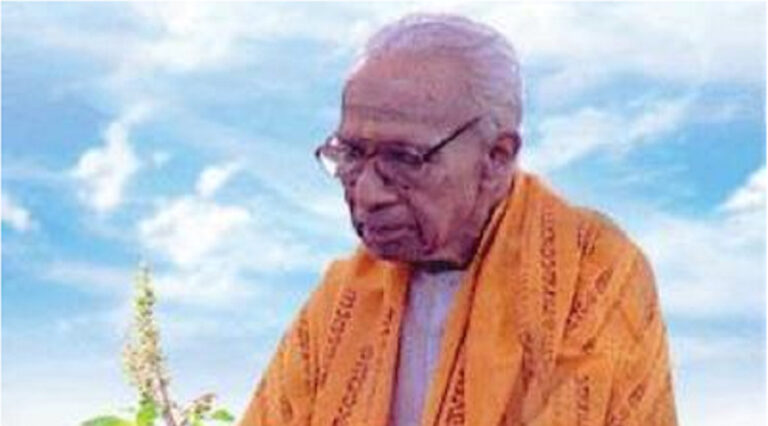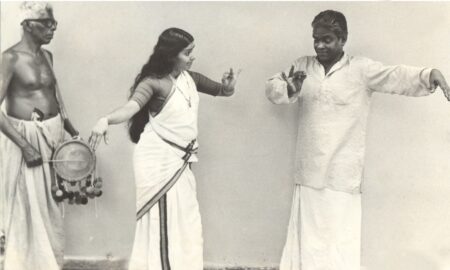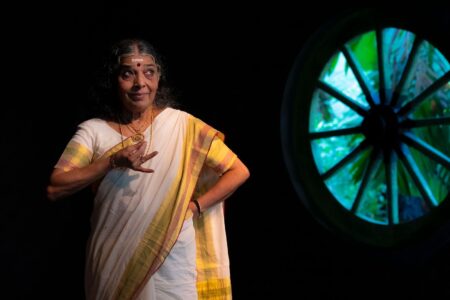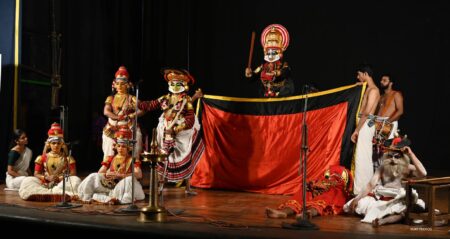Sanskrit Scholar, author and teacher, Prof K P Narayana Pisharody’s meritorious works on Koodiyattam was a big boost in popularising a hitherto uncommon art form and eventually getting it officially recognised by UNESCO
Seventeen years were completed on March 21 this year since we lost Prof. K P Narayana Pisharody, a Sanskrit scholar of repute, a prolific writer and a venerated guru for all scholars across the country.
Short-statured, soft-spoken and ever clad in spotless khadi clothes, ‘Sharody Maash’, as he was widely known, strode like a Colossus for the past eight decades in the field of Sanskrit literature, Vedas, and above all the classical performing arts of Kerala origin. So much so that for the innumerable pundits, purohitas and artistes who used to throng his home all these years, he was a ready reckoner and more significantly an embodiment of human values. The rare geniality that he exuded endeared him to society as a whole. The ingrafted knowledge of Sanskrit and the inimitable ability to express the same most lucidly made him the most sought-after guide to researchers and scholars. Pisharody was not a glamorous artiste. But his aficionados were a legion.
The strong footing he had in Sanskrit at an early age itself is imputed to the strict disciplining he had under the virtuoso Punnassery Neelakanta Sharma. Even a cursory talk with him cannot go without a reference to his guru that too with folding hands. The biography of the great scholar authored by Pisharody was a vehement expression of his guru bhakti. Writing has been a continuous process in his life throughout and he believed that it was the duty of a dedicated teacher to keep writing. As for his literary contributions, the myriad essays introducing Valmiki, Vyasa, Kalidasa, Ezhuthachan, Kumaran Aasaan, Vallathol and Ulloor for the students of literature had been noteworthy. These were later compiled under the titles ‘Manideepam’, ‘Srutimandapam’ and Kavihridayathilekku’.
Translating ‘Natyashastra’
What could be described as epochal among his contributions is the translation of sage Bharata’s treatise of dramaturgy, Natyashastra into Malayalam. This was published by Kerala Sahitya Akademi. But for this persevering work, the book, supposed to be the bible of Indian classical dance, music and theatre would have remained unintelligible to hundreds of performing artistes, connoisseurs and research students in Kerala. An expression of his literary ingenuity was that the translation contained Malayalam equivalents to all the Sanskrit slokas in Natyashastra.
Perhaps the inspiration for this work was the historical paper on Koodiyattam, which he was invited to present in a seminar organised at Guruvayur, in Thrissur district during the early ‘50s. “I was taken aback by such an invitation since, though I was well versed in Sanskrit and Sanskrit plays by that time, I had never seen a performance”, Pisharody had explained once. The next day itself he set out to meet the doyen Paimkulam Rama Chakyar. He was lucky to see the arangetram of a young Chakyar boy when Rama Chakyar had explained to him every feat. Soon he met other luminaries like Mani Madhava Chakyar, Ammannur Chachu Chakyar and Ammannur Madhava Chakyar with whom he spent days on end before giving the finishing touches to his paper.
Popularising Koodiyattam
Fortunately for him – or the art form – the Kozhikode station of All India Radio broadcast his speech in full that hogged much media attention. Noted litterateur N V Krishna Warrier who was also the editor of Malayalam daily Mathrubhoomi, then, was enthralled and requested him to prepare the synopsis of the Koodiyattam plays regularly staged at the Sree Vadakkunnathan Temple, Thrissur by the Ammannur family, to be carried in the newspaper. This was a breakthrough for the popularity of a hitherto uncommon art form. Even today, these writings that were later compiled in the form of books serve as a valuable guide to Koodiyattam rasikas.
But Pisharody’s painstaking efforts for popularising Koodiyattam did not end there. The kramadeepika (production manual) and attaprakaram (acting manual) of almost all the Sanskrit plays translated into Malayalam by him have been praiseworthy. These include Kalyanasougandhikam by Neelakanta, Asokavankamgam and Ascharyachoodamani by Saktibhadra, Swapanavasavadatham, Anguliyankam and Mathavilasam to mention only a few. Acceding to his request, Kerala Sangeetha Nataka Akademi published Bodhayana’s Bhagavathajjukam also, which was perhaps the last of his published work. Even after he was laid up, he was busy giving finishing touches to Ramapanivadan’s Madanakethu Charitam.
Encomiums and accolades chased him all through his life. Among them D Litt from the Sanskrit University, Ezhuthachan Puraskaram deserve special mention.
“An ideal teacher is an ideal student too. To him, learning was an ever-continuing process without end”. Prof. Pisharody was a great teacher who lived up to this dictum to the very end of his life.




